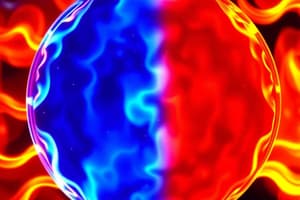Podcast
Questions and Answers
What is the term for the heat energy per unit mass transferred during a substance's change of state?
What is the term for the heat energy per unit mass transferred during a substance's change of state?
- Heat of fusion
- Thermal conductivity
- Specific heat capacity
- Latent heat (correct)
When heat is added to ice at its melting point, what happens to its temperature?
When heat is added to ice at its melting point, what happens to its temperature?
- It increases linearly.
- It decreases linearly.
- It remains constant. (correct)
- It fluctuates erratically.
If you close the steam outlet of a flask containing boiling water, increasing the pressure, what effect does this have on the boiling point?
If you close the steam outlet of a flask containing boiling water, increasing the pressure, what effect does this have on the boiling point?
- It decreases initially, then increases
- It increases. (correct)
- It decreases.
- It remains constant.
During boiling, when heat is added, what is observed alongside the change of state?
During boiling, when heat is added, what is observed alongside the change of state?
What is the relationship between pressure and boiling point based on the information provided?
What is the relationship between pressure and boiling point based on the information provided?
Why is copper considered a good material for cooking pots?
Why is copper considered a good material for cooking pots?
Why do plastic foams act as good thermal insulators?
Why do plastic foams act as good thermal insulators?
In the context of heat transfer, what characteristic of air makes it a poor conductor?
In the context of heat transfer, what characteristic of air makes it a poor conductor?
During summer days, why do concrete roofs tend to get very hot?
During summer days, why do concrete roofs tend to get very hot?
What materials are often used to insulate the ceilings of houses to reduce heat transfer?
What materials are often used to insulate the ceilings of houses to reduce heat transfer?
According to the context, which statement correctly describes the heat flow in a system with two different rods of the same length and cross sectional area, but different materials, in steady state?
According to the context, which statement correctly describes the heat flow in a system with two different rods of the same length and cross sectional area, but different materials, in steady state?
If a house's concrete roof transmits a lot of heat, it is most likely due to which property of concrete?
If a house's concrete roof transmits a lot of heat, it is most likely due to which property of concrete?
Two different metal rods of equal length and equal cross-sectional area are connected end-to-end. The heat current through the rods during a steady state:
Two different metal rods of equal length and equal cross-sectional area are connected end-to-end. The heat current through the rods during a steady state:
Why are steam burns generally more severe than burns from boiling water?
Why are steam burns generally more severe than burns from boiling water?
What does the latent heat of fusion (Lf) represent?
What does the latent heat of fusion (Lf) represent?
Which of the following correctly describes the direction of heat transfer?
Which of the following correctly describes the direction of heat transfer?
If $0.15 kg$ of ice at $0°C$ melts and then its temperature rises to $6.7°C$, how is the total heat gained calculated?
If $0.15 kg$ of ice at $0°C$ melts and then its temperature rises to $6.7°C$, how is the total heat gained calculated?
According to the provided text, which of the following is NOT a method of heat transfer?
According to the provided text, which of the following is NOT a method of heat transfer?
What does 's' represent in heat transfer calculations (e.g., $ms(θ_f − θ_i)$)?
What does 's' represent in heat transfer calculations (e.g., $ms(θ_f − θ_i)$)?
What is the significance of latent heat in phase changes?
What is the significance of latent heat in phase changes?
If 3 kg of ice at -12°C is to be converted to steam at 100°C, what is the first step in calculating the total heat required?
If 3 kg of ice at -12°C is to be converted to steam at 100°C, what is the first step in calculating the total heat required?
What is the primary mechanism that drives natural convection?
What is the primary mechanism that drives natural convection?
How does forced convection differ from natural convection?
How does forced convection differ from natural convection?
Why does hot fluid rise in natural convection?
Why does hot fluid rise in natural convection?
Which of the following is an example of a system that uses forced convection?
Which of the following is an example of a system that uses forced convection?
What are the 'trade winds' a result of?
What are the 'trade winds' a result of?
According to the content, where does the air descend in the global convection cycle?
According to the content, where does the air descend in the global convection cycle?
Why is the air at the equator moving eastward faster than the air close to the poles?
Why is the air at the equator moving eastward faster than the air close to the poles?
What causes the cycle to be reversed, creating convection currents?
What causes the cycle to be reversed, creating convection currents?
A brass wire is cooled from an initial temperature to -39 °C. Given the wire's diameter is 2.0mm, its coefficient of linear expansion is $2.0 \times 10^{-5} K^{-1}$, and its Young's modulus is $0.91 \times 10^{11} Pa$, what tension is developed in the wire?
A brass wire is cooled from an initial temperature to -39 °C. Given the wire's diameter is 2.0mm, its coefficient of linear expansion is $2.0 \times 10^{-5} K^{-1}$, and its Young's modulus is $0.91 \times 10^{11} Pa$, what tension is developed in the wire?
A combined rod, consisting of a 50 cm brass rod and a 50 cm steel rod, both with a 3.0mm diameter at 40°C, is heated to 250°C. What is the total change in length, given the coefficients of linear expansion are $2.0 \times 10^{-5} K^{-1}$ for brass and $1.2 \times 10^{-5} K^{-1}$ for steel?
A combined rod, consisting of a 50 cm brass rod and a 50 cm steel rod, both with a 3.0mm diameter at 40°C, is heated to 250°C. What is the total change in length, given the coefficients of linear expansion are $2.0 \times 10^{-5} K^{-1}$ for brass and $1.2 \times 10^{-5} K^{-1}$ for steel?
Glycerine's coefficient of volume expansion is $49 \times 10^{-5} K^{-1}$. What is the fractional change in its density when its temperature increases by 30°C?
Glycerine's coefficient of volume expansion is $49 \times 10^{-5} K^{-1}$. What is the fractional change in its density when its temperature increases by 30°C?
A 10kW drilling machine operates for 2.5 minutes on an 8.0 kg aluminum block. Assuming 50% of the power heats the block, and given the specific heat of aluminum is $0.91 J g^{-1} K^{-1}$, what is the temperature increase of the block?
A 10kW drilling machine operates for 2.5 minutes on an 8.0 kg aluminum block. Assuming 50% of the power heats the block, and given the specific heat of aluminum is $0.91 J g^{-1} K^{-1}$, what is the temperature increase of the block?
What does the Stefan-Boltzmann law describe?
What does the Stefan-Boltzmann law describe?
What is the significance of the emissivity (e) in the context of thermal radiation?
What is the significance of the emissivity (e) in the context of thermal radiation?
A 2.5 kg copper block at 500°C is placed on a large ice block. Given the specific heat of copper is $0.39 J g^{-1} K^{-1}$ and the heat of fusion of water is $335 J g^{-1}$, what is the maximum mass of ice that can melt?
A 2.5 kg copper block at 500°C is placed on a large ice block. Given the specific heat of copper is $0.39 J g^{-1} K^{-1}$ and the heat of fusion of water is $335 J g^{-1}$, what is the maximum mass of ice that can melt?
According to Stefan-Boltzmann law, how does the total energy radiated by an object change if its absolute temperature is doubled?
According to Stefan-Boltzmann law, how does the total energy radiated by an object change if its absolute temperature is doubled?
In the experiment described, what is the initial temperature T1 primarily intended to represent?
In the experiment described, what is the initial temperature T1 primarily intended to represent?
During the cooling experiment, at what point would you stop the temperature readings of the water?
During the cooling experiment, at what point would you stop the temperature readings of the water?
What is the crucial purpose of gently stirring the water in the calorimeter during the experiment?
What is the crucial purpose of gently stirring the water in the calorimeter during the experiment?
If a body has an emissivity of 0.7, what does this indicate when compared to a perfect radiator?
If a body has an emissivity of 0.7, what does this indicate when compared to a perfect radiator?
What is the correct unit for the Stefan-Boltzmann constant (σ) as mentioned in the text?
What is the correct unit for the Stefan-Boltzmann constant (σ) as mentioned in the text?
Flashcards
Latent Heat
Latent Heat
The amount of heat energy absorbed or released per unit mass of a substance during a change of state (e.g., melting, freezing, boiling, condensation) without a change in temperature.
Latent Heat of Fusion
Latent Heat of Fusion
The specific amount of heat energy required to melt 1 gram of a substance at its melting point.
Latent Heat of Vaporization
Latent Heat of Vaporization
The specific amount of heat energy needed to vaporize 1 gram of a substance at its boiling point.
Boiling Point
Boiling Point
Signup and view all the flashcards
Boiling Point and Pressure Relationship
Boiling Point and Pressure Relationship
Signup and view all the flashcards
Thermal Conductivity
Thermal Conductivity
Signup and view all the flashcards
Latent heat of fusion (Lf)
Latent heat of fusion (Lf)
Signup and view all the flashcards
Good Conductors
Good Conductors
Signup and view all the flashcards
Latent heat of vaporization (Lv)
Latent heat of vaporization (Lv)
Signup and view all the flashcards
Good Insulators
Good Insulators
Signup and view all the flashcards
Why are steam burns more severe?
Why are steam burns more severe?
Signup and view all the flashcards
Conduction
Conduction
Signup and view all the flashcards
Heat Current (H)
Heat Current (H)
Signup and view all the flashcards
Steady State
Steady State
Signup and view all the flashcards
Convection
Convection
Signup and view all the flashcards
Radiation
Radiation
Signup and view all the flashcards
Heat Flow Equation
Heat Flow Equation
Signup and view all the flashcards
Temperature vs. heat graph for water
Temperature vs. heat graph for water
Signup and view all the flashcards
Thermal Equilibrium
Thermal Equilibrium
Signup and view all the flashcards
Specific heat capacity
Specific heat capacity
Signup and view all the flashcards
Heat Retention
Heat Retention
Signup and view all the flashcards
Forced Convection
Forced Convection
Signup and view all the flashcards
Natural Convection
Natural Convection
Signup and view all the flashcards
Sea Breeze
Sea Breeze
Signup and view all the flashcards
Land Breeze
Land Breeze
Signup and view all the flashcards
Trade Winds
Trade Winds
Signup and view all the flashcards
Earth's Rotation's Influence on Trade Winds
Earth's Rotation's Influence on Trade Winds
Signup and view all the flashcards
Unequal Solar Heating of the Earth
Unequal Solar Heating of the Earth
Signup and view all the flashcards
Stefan-Boltzmann Law
Stefan-Boltzmann Law
Signup and view all the flashcards
Emissivity (e)
Emissivity (e)
Signup and view all the flashcards
Stefan-Boltzmann Constant (σ)
Stefan-Boltzmann Constant (σ)
Signup and view all the flashcards
Net Rate of Radiant Energy Loss
Net Rate of Radiant Energy Loss
Signup and view all the flashcards
Blackbody
Blackbody
Signup and view all the flashcards
Coefficient of linear expansion
Coefficient of linear expansion
Signup and view all the flashcards
Thermal stress
Thermal stress
Signup and view all the flashcards
Study Notes
Thermal Properties of Matter
- All substances expand when heated and contract when cooled. This change in dimensions is called thermal expansion.
- Linear expansion refers to the change in length.
- Area expansion refers to the change in area.
- Volume expansion refers to the change in volume.
- The fractional change in length, area, or volume is proportional to the change in temperature.
- The coefficient of linear expansion (α₁) is a material property that quantifies how much a material's length changes with a unit change in temperature.
- The coefficient of area expansion (α₂) is twice the coefficient of linear expansion.
- The coefficient of volume expansion (αᵥ) is three times the coefficient of linear expansion.
- Thermal expansion has many applications in everyday life, such as in bridges and buildings.
- Water is an exception, exhibiting anomalous expansion; its volume decreases between 0°C and 4°C, causing a maximum in density at 4°C.
- The change of state involves physical transformations between solid, liquid, and gaseous phases.
- Heat is absorbed or released during phase transitions. The heat required to change the state of a substance without changing its temperature is called the latent heat.
- Latent heat of fusion is for solid-to-liquid transitions.
- Latent heat of vaporisation is for liquid-to-gaseous transitions.
- The rate of heat transfer depends on the temperature difference between the body and its surroundings.
- The three modes of heat transfer are: Conduction, Convection and Radiation.
- Conduction is heat transfer through direct contact.
- Convection is heat transfer by fluid motion (in liquids or gases).
- Radiation is heat transfer through electromagnetic waves.
- Newton's Law of Cooling describes the rate of heat loss from a body to its surroundings. The rate of cooling is proportional to the temperature difference between the body and its surroundings.
Measurement of Temperature
- Temperature is a measure of the average kinetic energy of the particles in a substance.
- Thermometers measure temperature, typically using a physical property that changes with temperature (e.g., the volume of a liquid or the resistance of a wire).
- The Celsius scale (℃) uses the ice point (0℃) and the steam point (100℃) of water under standard conditions as reference.
- The Fahrenheit scale (°F) uses different reference points.
- The Kelvin scale (K) is an absolute temperature scale. Absolute zero is the lowest possible temperature (0K).
Specific Heat Capacity
- Specific heat capacity is the amount of heat required to raise the temperature of one unit mass of a substance by one degree Celsius (or Kelvin).
- It is a property of a substance.
- The specific heat capacity of water is relatively high, impacting many environmental and biological processes.
Calorimetry
- Calorimetry is the measurement of heat transfer.
- It involves using a calorimeter to determine the heat absorbed or released by a substance during a physical or chemical process.
- The principle of calorimetry is based on the conservation of energy. The amount of heat lost by one object is equal to the amount of heat gained by another object.
Ideal Gas Equation
- The ideal gas equation relates the pressure, volume, and temperature of an ideal gas.
- PV = nRT, where P is pressure, V is volume, n is the number of moles, R is the ideal gas constant, and T is the absolute temperature.
- The ideal gas equation is applicable to many gases at low densities and high temperatures.
Thermal Expansion
- Thermal expansion is the increase in size of a material due to a rise in temperature.
- Thermal expansion plays a crucial role in many engineering applications, such as the design of bridges and buildings, since materials expand and contract in response to temperature changes.
Studying That Suits You
Use AI to generate personalized quizzes and flashcards to suit your learning preferences.




